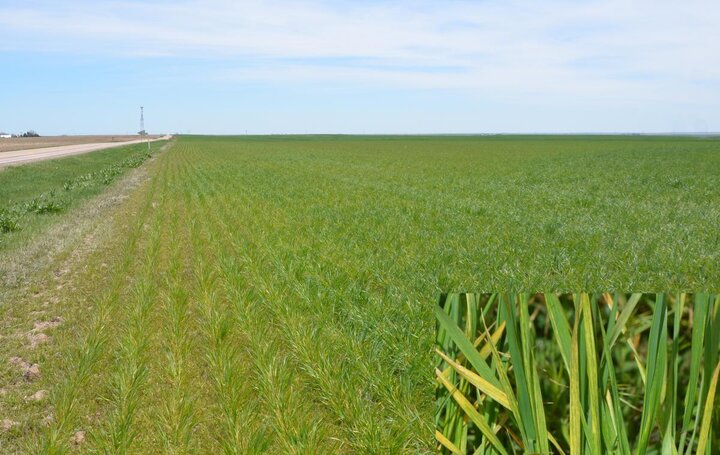



On May 3, stripe rust was observed for the first time at Havelock Farm in Lincoln (Lancaster County). Incidence (percentage of infected plants) was low and severity (percentage of diseased leaf area) ranged from trace to high, but leaf damage was not apparent because infections were still new (Figure 1). In contrast, at the Agricultural Research and Development Center (ARDC) near Mead (Saunders County) on May 3, infections had spread from small hot spots one to two weeks earlier to larger areas in research plots, and leaf damage manifested as chlorosis (yellowing) and necrosis (death of leaf tissue) was apparent (Figure 2). Wheat growth stage at these two locations ranged from flag leaf emergence to heading.
On May 5, field surveys found stripe rust to be widespread in the west central and southern Panhandle of Nebraska. The flag leaf had not emerged or was just starting to emerge in these parts of the state. The counties surveyed were Lincoln, Keith, Deuel, Cheyenne, Kimball, and Banner. Incidence was high and severity was mostly low (Figure 3) except in one field in Banner County planted with a susceptible variety, where severity was moderate to high (Figure 4).
Apart from stripe rust, severe levels of wheat streak mosaic virus were observed in a field in Deuel County (Figures 5 and 6). In the southern Panhandle, several fields had large ponds or were flooded due to recent rains (Figure 7).
Management
Stripe rust development has been slow this year due to a period of dry weather in April. Therefore, damage and yield loss due to stripe rust are not expected to be as severe as in 2015. However, current weather conditions are favorable for development and spread of stripe rust. Monitor your fields and be prepared to apply a fungicide to protect the flag leaf. See a list of fungicides and their efficacies in Table 1, compiled by the North Central Regional Committee on Management of Small Grain Diseases (NCERA-184). The products highlighted in yellow were added to the table in 2016.
Wheat streak mosaic cannot be controlled once it occurs. It is best managed by
- controlling volunteer wheat and grassy weeds before fall planting and
- avoiding planting wheat next to late maturing corn.
A few recently released wheat varieties have good resistance to wheat streak mosaic.


